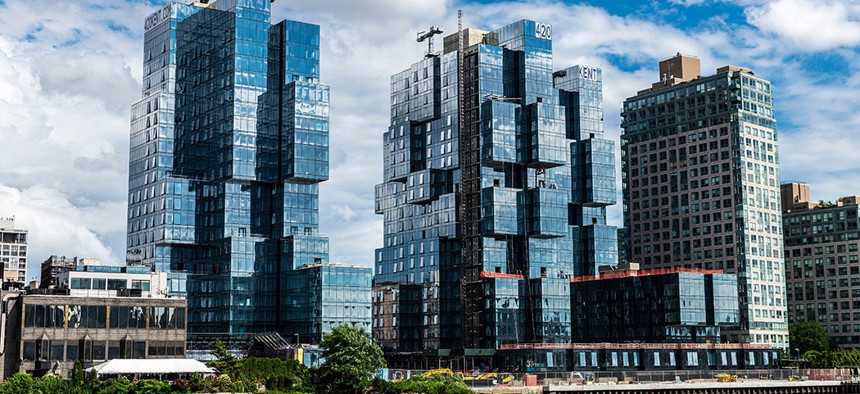New York City has implemented an ambitious inclusive zoning program, which uses incentives to encourage developers to build more affordable housing units. Inclusive zoning is not a panacea, but it is a useful policy that can help to address the crisis of affordable housing facing numerous urban areas in the United States. These programs, however, might be threatened by litigation. A challenge to a California inclusive zoning plan might be coming soon to the Supreme Court – and there’s a real chance that it would succeed, throwing the viability of other inclusive zoning plans into doubt.
The case being appealed to the Supreme Court involves inclusive zoning regulations in Marin County, a wealthy suburban area near San Francisco. The county, infamous for intense NIMBY opposition to increases in housing density, has introduced inclusive zoning as part of an agreement with the federal Department of Housing and Urban Development to allow development in predominantly white neighborhoods. The case against the Marin regulations has been brought by Dartmond Cherk. Cherk was assessed an affordable housing fee of nearly $40,000 in exchange for receiving a permit to divide a residential lot he owns. (Instead of paying the fee, Cherk could also have set aside some property for affordable housing.) His suit claims that imposing this fee as a requirement to receive a permit violates the Fifth Amendment, which prevents the state from taking property for public use without just compensation.
For most of American history, Cherk would not have had much of a case. Traditionally, only an actual expropriation of private property by the state was considered a “taking.” And while the Supreme Court developed the concept of a “regulatory taking” in the 20th century, this initially applied only to cases where a state regulation almost entirely destroyed a property’s value. But in the 1987 case Nollan v. California Coastal Commission, a 5-4 majority opinion written by the late Antonin Scalia held that a requirement to provide a public easement on beachfront property in exchange for receiving a permit to build a larger house violated the takings clause because the there was an insufficient “nexus” between the state’s condition and a “legitimate state interest.” Cherk, similarly, argues that his plans for his property are not sufficiently related to the county’s legitimate interest in creating affordable housing and are therefore unconstitutional under the “unconstitutional conditions” doctrine.
Admittedly, Marin County’s government is a less-than-sympathetic actor here. Like most of the local governments in affluent coastal areas of California, its attempts to address the affordable housing crisis are too little and too late. One of the briefs submitted on behalf of Cherk is not wrong to say that the affordable housing problem is of “local government’s own making” and is the “direct result of growth controls, zoning regulations, and general opposition to new development in the coastal metropolitan areas like Marin County.” Aggressive, pro-density upzoning and subsidized public housing are, all things being equal, better alternatives than imposing large permit fees on individual landholders.
That a policy is suboptimal, however, does not make it unconstitutional. State and local governments need a variety of tools to address the very serious housing shortages in many high-demand urban areas. New York City created mandatory inclusionary zoning because it lacks the taxation authority under state law to raise the funds needed to build anywhere near enough public housing to meet its needs for additional affordable housing.
The California court held that the “unconstitutional conditions” doctrine does not apply because Cherk could have made affordable housing available and avoided paying a fee to get a permit to subsidize his property, a reasonable conclusion. Should the Supreme Court decide to rule at least some forms of inclusive zoning unconstitutional, this would take a potentially important policy tool away from governments. It’s also worth noting that, while there have been a lot of policy failures that have led to the affordable housing crisis in places like Marin County, incumbent landowners have seen the shortage of housing – created by local governmental refusal to increase housing supply to meet demand – boost the value of their properties. When a county or city then does selectively upzone, as New York has, the property owners are set up for a huge windfall. Imposing conditions that they give back a little when building up is then more justified.
And there’s a strong hint of bait-and-switch in the arguments made by supporters of the suit. They would block mandatory inclusionary zoning, but also the alternatives. Don’t expect support from libertarian groups when it comes time to fight for high-density upzoning or increased public housing.
With the most conservative Supreme Court in decades firmly in place, however, the challenge to Marin County would have a reasonable chance of succeeding if the Court take the case. If it does, the implications for New York City’s inclusive zoning are not entirely clear.
New York City’s policy creates three different kinds of inclusionary housing “zones.” In Mandatory Inclusionary Housing Areas, affordable units are required, and their constitutionality would almost certainly face a tough challenge if the suit against Marin County succeeds. In the other two zones, landowners are potentially fined if they don’t offer affordable units, but are given a bonus if they build larger buildings with affordable units. Because these zones use the carrot as well as the stick, they are not identical to the Marin County policy – but they would still be constitutionally vulnerable.
New York City has other tools if some or all of its inclusive zoning policies are struck down:most notably upzoning to increase density and spending more on public housing. It should be using those alternatives more aggressively anyway. But it would still be better for the Court to defer to local governments trying to address a very serious crisis.


